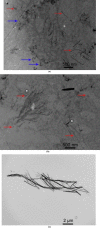Influence of the physiochemical properties of superparamagnetic iron oxide nanoparticles on amyloid β protein fibrillation in solution
- PMID: 23509983
- PMCID: PMC3605812
- DOI: 10.1021/cn300196n
Influence of the physiochemical properties of superparamagnetic iron oxide nanoparticles on amyloid β protein fibrillation in solution
Abstract
Superparamagnetic iron oxide nanoparticles (SPIONs) are recognized as promising nanodiagnostic materials due to their biocompatibility, unique magnetic properties, and their application as multimodal contrast agents. As coated SPIONs have potential use in the diagnosis and treatment of various brain diseases such as Alzheimer's, a comprehensive understanding of their interactions with Aβ and other amyloidogenic proteins is essential prior to their clinical application. Here we demonstrate the effect of thickness and surface charge of the coating layer of SPIONs on the kinetics of fibrillation of Aβ in aqueous solution. A size and surface area dependent "dual" effect on Aβ fibrillation was observed. While lower concentrations of SPIONs inhibited fibrillation, higher concentrations increased the rate of Aβ fibrillation. With respect to coating charge, it is evident that the positively charged SPIONs are capable of promoting fibrillation at significantly lower particle concentrations compared with negatively charged or uncharged SPIONs. This suggests that in addition to the presence of particles, which affect the concentration of monomeric protein in solution (and thereby the nucleation time), there are also effects of binding on the protein conformation.
Figures






Similar articles
-
Effect of PEGylated superparamagnetic iron oxide nanoparticles (SPIONs) under magnetic field on amyloid beta fibrillation process.Mater Sci Eng C Mater Biol Appl. 2016 Feb;59:390-397. doi: 10.1016/j.msec.2015.10.026. Epub 2015 Oct 22. Mater Sci Eng C Mater Biol Appl. 2016. PMID: 26652388
-
Effect of superparamagnetic nanoparticles coated with various electric charges on α-synuclein and β-amyloid proteins fibrillation process.Int J Nanomedicine. 2019 Jan 23;14:799-808. doi: 10.2147/IJN.S190354. eCollection 2019. Int J Nanomedicine. 2019. PMID: 30774334 Free PMC article.
-
PEGylated superparamagnetic iron oxide nanoparticles (SPIONs) ameliorate learning and memory deficit in a rat model of Alzheimer's disease: Potential participation of STIMs.Neurotoxicology. 2021 Jul;85:145-159. doi: 10.1016/j.neuro.2021.05.013. Epub 2021 May 29. Neurotoxicology. 2021. PMID: 34058247
-
Alzheimer's disease: pathophysiology and applications of magnetic nanoparticles as MRI theranostic agents.ACS Chem Neurosci. 2013 Nov 20;4(11):1417-29. doi: 10.1021/cn4001582. Epub 2013 Sep 26. ACS Chem Neurosci. 2013. PMID: 24024702 Free PMC article. Review.
-
Unveiling the theranostic potential of SPIONs in Alzheimer's disease management.J Psychiatr Res. 2024 Nov;179:244-256. doi: 10.1016/j.jpsychires.2024.09.022. Epub 2024 Sep 20. J Psychiatr Res. 2024. PMID: 39321523 Review.
Cited by
-
Hybrid Graphene Oxide Based Plasmonic-Magnetic Multifunctional Nanoplatform for Selective Separation and Label-Free Identification of Alzheimer's Disease Biomarkers.ACS Appl Mater Interfaces. 2015 Jun 24;7(24):13693-700. doi: 10.1021/acsami.5b03619. Epub 2015 Jun 9. ACS Appl Mater Interfaces. 2015. PMID: 26027901 Free PMC article.
-
Nanomedicines in the Management of Alzheimer's Disease: Current View and Future Prospects.Front Aging Neurosci. 2022 Jul 8;14:879114. doi: 10.3389/fnagi.2022.879114. eCollection 2022. Front Aging Neurosci. 2022. PMID: 35875806 Free PMC article. Review.
-
Biomedical Applications of Zeolitic Nanoparticles, with an Emphasis on Medical Interventions.Int J Nanomedicine. 2020 Jan 21;15:363-386. doi: 10.2147/IJN.S234573. eCollection 2020. Int J Nanomedicine. 2020. PMID: 32021185 Free PMC article. Review.
-
Human serum transferrin fibrils: nanomineralisation in bacteria and destruction of red blood cells.Chembiochem. 2015 Jan 2;16(1):149-55. doi: 10.1002/cbic.201402458. Epub 2014 Dec 4. Chembiochem. 2015. PMID: 25476866 Free PMC article.
-
Engineering Iron Oxide Nanoparticles for Clinical Settings.Nanobiomedicine (Rij). 2014 Jan 1;1:2. doi: 10.5772/58841. eCollection 2014 Jan-Dec. Nanobiomedicine (Rij). 2014. PMID: 30023013 Free PMC article.
References
-
- Cleary J. P.; Walsh D. M.; Hofmeister J. J.; Shankar G. M.; Kuskowski M. A.; Selkoe D. J.; Ashe K. H. (2005) Natural oligomers of the amyloid-beta protein specifically disrupt cognitive function. Nat. Neurosci. 8, 79–84. - PubMed
-
- Walsh D. M.; Klyubin I.; Shankar G. M.; Townsend M.; Fadeeva J. V.; Betts V.; Podlisny M. B.; Cleary J. P.; Ashe K. H.; Rowan M. J.; Selkoe D. J. (2005) The role of cell-derived oligomers of abeta in alzheimer‘s disease and avenues for therapeutic intervention. Biochem. Soc. Trans. 33, 1087–1090. - PubMed
-
- Selkoe D. J. (2002) Alzheimer s disease is a synaptic failure. Science 298, 789–791. - PubMed
-
- Lambert M. P.; Barlow A. K.; Chromy B. A.; Edwards C.; Freed R.; Liosatos M.; Morgan T. E.; Rozovsky I.; Trommer B.; Viola K. L.; Wals P.; Zhang C.; Finch C. E.; Krafft G. A.; Klien W. L. (1998) Diffusible, nonfibrillar ligands derived from Ab1–42 are potent central nervous system neurotoxins. Proc. Natl. Acad. Sci. U.S.A. 95, 6448–6453. - PMC - PubMed
-
- Walsh D.; Klyubin I.; Fadeeva J. V.; Cullen W. K.; Anwyl R.; Wolfe M. S.; Rowan M. J.; Selkoe D. J. (2002) Naturally secreted oligomers of amyloid b protein potently inhibit hippocampal long-term potentiation in vivo. Nature 416, 535–539. - PubMed
Publication types
MeSH terms
Substances
LinkOut - more resources
Full Text Sources
Other Literature Sources
Molecular Biology Databases
Research Materials

